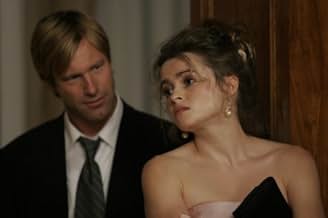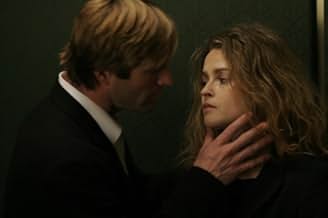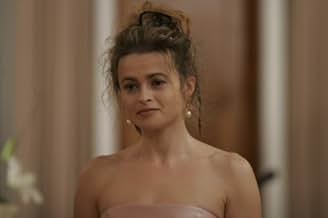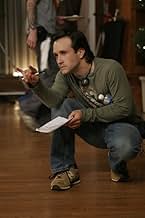NOTE IMDb
6,9/10
13 k
MA NOTE
Ajouter une intrigue dans votre langueWhen a man and woman flirt with each other at a wedding reception, the sexual tension seems spontaneous. As they break from the party to a hotel room, the flirtation turns into a night fille... Tout lireWhen a man and woman flirt with each other at a wedding reception, the sexual tension seems spontaneous. As they break from the party to a hotel room, the flirtation turns into a night filled with passion and remorse.When a man and woman flirt with each other at a wedding reception, the sexual tension seems spontaneous. As they break from the party to a hotel room, the flirtation turns into a night filled with passion and remorse.
- Réalisation
- Scénario
- Casting principal
- Récompenses
- 3 victoires et 4 nominations au total
Veronica Reyes-How
- Girl on Street
- (as Veronica Reyes)
Noah Abrams
- Partygoer
- (non crédité)
Will Carter
- Wedding DJ
- (non crédité)
Madison Davenport
- British Girl
- (non crédité)
Avis à la une
There are so many conventional movies about adulterous chance meetings that the prospects of another one wouldn't seem to be too promising. However, director Hans Canosa takes a rather novel approach with this small-scale 2006 indie film in looking at the illicit one-night stand with a pervasive split-screen process. Most often, the two sides reflect the perspectives from the man and woman at the center of the story, and at other times, we see their individual memories as flashbacks to their youthful courtship. Initially, the gimmicky aspect of watching the duality of the action is rather jarring, but it gradually becomes a dramatically effective means for exhibiting the dynamics of the two characters in real time. Gabrielle Zevin's sharply delineated, often amusing dialogue also helps to bring an immediacy to what could have been a predictably drawn situation.
The intimate, verbose plot itself turns on several contrivances, some more forgivable than others (like the absence of names for the lovers and the misunderstanding arising from matching cell phones). Regardless, it's really the adroit charm and emotional dexterity of the actors that sets this movie apart. Playing yet another rascally man-child, Aaron Eckhart adds shades of mid-life romantic vulnerability that make his character likeably flawed. But the picture really belongs to Helena Bonham Carter's richly textured performance as the woman, easily her best work since 1997's "The Wings of the Dove". As a complacent married woman who feels herself hurtling palpably toward forty, she provides such revealing nuance with each scene that I ended up wondering more about her character's fate than his. With her sad dark eyes and pouty mouth, she looks more like legendary French actress Jeanne Moreau as the years pass.
Shot in only thirteen days and with a running time of only 84 minutes, the movie is quite small in scope, but it is also a relatively undiscovered gem that will hopefully take on new life on DVD. Speaking of which, the 2007 DVD has a surprisingly robust number of extras beginning with Canosa's thoughtful commentary track. Also included are an entertaining 25-minute interview with an easily bantering Eckhart and Carter from the Telluride Film Festival; an insightful five-minute short with the director showing a demo of his dual-camera film-making technique; a helpful four-minute explanation of why split-screen was used specifically for the film; and a less interesting, more technical twenty-minute demonstration of how Canosa used Apple Final Cut Pro software to make his complex edits.
The intimate, verbose plot itself turns on several contrivances, some more forgivable than others (like the absence of names for the lovers and the misunderstanding arising from matching cell phones). Regardless, it's really the adroit charm and emotional dexterity of the actors that sets this movie apart. Playing yet another rascally man-child, Aaron Eckhart adds shades of mid-life romantic vulnerability that make his character likeably flawed. But the picture really belongs to Helena Bonham Carter's richly textured performance as the woman, easily her best work since 1997's "The Wings of the Dove". As a complacent married woman who feels herself hurtling palpably toward forty, she provides such revealing nuance with each scene that I ended up wondering more about her character's fate than his. With her sad dark eyes and pouty mouth, she looks more like legendary French actress Jeanne Moreau as the years pass.
Shot in only thirteen days and with a running time of only 84 minutes, the movie is quite small in scope, but it is also a relatively undiscovered gem that will hopefully take on new life on DVD. Speaking of which, the 2007 DVD has a surprisingly robust number of extras beginning with Canosa's thoughtful commentary track. Also included are an entertaining 25-minute interview with an easily bantering Eckhart and Carter from the Telluride Film Festival; an insightful five-minute short with the director showing a demo of his dual-camera film-making technique; a helpful four-minute explanation of why split-screen was used specifically for the film; and a less interesting, more technical twenty-minute demonstration of how Canosa used Apple Final Cut Pro software to make his complex edits.
Given the way the story is told, "Conversations with Other Women" plays out as somewhat of a romantic mystery demanding a slow, selective unraveling by a keen audience. It follows two deliberately unnamed characters (a man and a woman) through the latter part of a wedding reception and holds on them through their evening together. Earlier works like Richard Linklater's duo "Before Sunrise" and "Before Sunset" come instantly to mind. Although it might not literally be conveyed in real time, there's such immediacy to the conversation that ensues. Like Linklater's films the dialogue heavy film never feels overbearing and stage-like, possibly due to the writing and possibly due to the visual technique that will no doubt color many reviews and comments about the film. It's told with a constant use of split-screen, in an attempt to present two perspectives. Mostly the use of this style assists with pacing, and never fully follows through on the promise of conveying opposing story lines. Regardless the choice to use split-screen never becomes flashy, like it did in when it came into vogue in the mid-1960s, but it does seem more fueled by digital ability than narrative necessity. Whether it's this curious technique, the impressive performances of Aaron Eckhart and Helena Bonham Carter, or the subtle screen writing, "Conversations with Other Women" seems to effortlessly become one of those quickly cherished works that demands you hang onto every word, every gesture. It's really a beautiful work and has the potential to become a classic love story couples and hopeless romantics will go to for years to come. But it very likely won't.
From the moment I saw the trailer for CONVERSATIONS WITH OTHER WOMEN I wanted to see this film. The combination of Helena Bonham Carter and the terrific Aaron Eckhart together on the screen with dialog that is out of this world, both funny and sad, at the same time, makes this film an intelligent and smart artistic piece of work. And the split screen makes it even more interesting as you get to watch the actors pull off such marvelous performances. I want to see this film again just to see what I might have missed.
When the film begins at a wedding and continues with the momentum of the attraction a couple feel for one another, it is impossible not to think of your own wedding experiences and perhaps the magic of meeting "the right one" as time ticks away in your life. New York is the perfect location for this film and as the last frame of the film appears before the credits roll, you simply don't want to have this couple leave. CONVERSATIONS WITH OTHER WOMEN makes you really think about what is important in your personal life and when you finally meet that "special person", hold on to him, or her, for the rest of your life. Bravo, Hans Canosa for this brilliant film.
When the film begins at a wedding and continues with the momentum of the attraction a couple feel for one another, it is impossible not to think of your own wedding experiences and perhaps the magic of meeting "the right one" as time ticks away in your life. New York is the perfect location for this film and as the last frame of the film appears before the credits roll, you simply don't want to have this couple leave. CONVERSATIONS WITH OTHER WOMEN makes you really think about what is important in your personal life and when you finally meet that "special person", hold on to him, or her, for the rest of your life. Bravo, Hans Canosa for this brilliant film.
I was lucky enough to see this movie on Monday, September 5, the last day of Telluride 2005. There were five other screenings that had sold out before that. I'd heard the about the film, but wasn't sure I had to see it until I read Roger Ebert's review of the film on his website's festival writeup.
I didn't think that a movie made entirely in split screen could be anything but a gimmick. But after seeing the film, I agree with Ebert--the split screen comes to seem necessary. The split screen is used not only to show the simultaneous actions and reactions of both characters, but also shows flashbacks juxtaposed with the present, alternate versions of the present, and moments imagined or hoped by the characters that quickly return to reality. Sometimes the present is fractured into more than one emotion for a given line or action, showing an actor performing the same moment in different ways. The editing is assured and masterful, employing storytelling techniques that couldn't exist without the split screen. The writing is brilliant, full of humor and insight. The movie is like nothing you've ever seen before.
Aaron Eckhart and Helena Bonham Carter are amazing--funny and heartbreaking at the same time. I really can't wait to see this movie again. If a movie ever rewarded two viewings, it's a movie that plays in two frames.
I didn't think that a movie made entirely in split screen could be anything but a gimmick. But after seeing the film, I agree with Ebert--the split screen comes to seem necessary. The split screen is used not only to show the simultaneous actions and reactions of both characters, but also shows flashbacks juxtaposed with the present, alternate versions of the present, and moments imagined or hoped by the characters that quickly return to reality. Sometimes the present is fractured into more than one emotion for a given line or action, showing an actor performing the same moment in different ways. The editing is assured and masterful, employing storytelling techniques that couldn't exist without the split screen. The writing is brilliant, full of humor and insight. The movie is like nothing you've ever seen before.
Aaron Eckhart and Helena Bonham Carter are amazing--funny and heartbreaking at the same time. I really can't wait to see this movie again. If a movie ever rewarded two viewings, it's a movie that plays in two frames.
I saw this at the LA Film Festival and frankly was expecting it to be very artsy, interesting, and a real downer. It was far above all those things. The split screen is easy to adjust to and really wraps you in, you're quite fascinated to see what these two people will do next. I loved the set up; it lent itself to a nice surprise for the audience and felt completely natural.
What really shines in this movie is the dialog...it's some of the most brilliant original dialog between two people with a shared past that I've ever heard. During the Q&A afterward, I was actually a bit disappointed the director didn't give the screenwriter more credit for her amazing script (which she wrote in three weeks). It's so engaging and natural, you might guess it was improvised...but 99% came directly off the page.
Helena Bonham Carter and Aaron Eckel really landed plum roles for themselves in this story and I've never loved them more than here. The reviewer who thought Helena was miscast is way off in his perception. It's not about wedding sexual tension (good grief) and it's far from a chick flick...it's about the deep connection between two people regardless of time and similar to "Before Sunrise," etc., yet quite different, but I don't want to spoil it.
The film is touching, very humorous, and deeply thoughtful. You will want to watch it several times to catch all that happens.
What really shines in this movie is the dialog...it's some of the most brilliant original dialog between two people with a shared past that I've ever heard. During the Q&A afterward, I was actually a bit disappointed the director didn't give the screenwriter more credit for her amazing script (which she wrote in three weeks). It's so engaging and natural, you might guess it was improvised...but 99% came directly off the page.
Helena Bonham Carter and Aaron Eckel really landed plum roles for themselves in this story and I've never loved them more than here. The reviewer who thought Helena was miscast is way off in his perception. It's not about wedding sexual tension (good grief) and it's far from a chick flick...it's about the deep connection between two people regardless of time and similar to "Before Sunrise," etc., yet quite different, but I don't want to spoil it.
The film is touching, very humorous, and deeply thoughtful. You will want to watch it several times to catch all that happens.
Le saviez-vous
- AnecdotesThe film contains 117 visual effects shots, all of which are designed to be "invisible". When the Visual Effects Supervisor, Kwesi Collisson, solicited bids from VFX houses, he received an initial estimated VFX budget of over $1 million, followed by a $400,000 "low budget" estimate. Mr. Collisson decided to execute all of the effects himself, spending four months using Adobe After Effects and Shake software to complete the necessary shots.
- GaffesThe last scene is supposed to be set at 4am, but the natural light is more like 8am or later.
- Crédits fousAfter the actor credits in the opening, the remainder are shown with the attribute (e.g., "Casting by") under/after the name (e.g., Bllly Hopkins). This is the opposite of the norm, where the attribute is always on top/before.
- ConnexionsFeatured in 2006 Independent Spirit Awards (2006)
- Bandes originalesLe plus Beau du Quartier
Music by Carla Bruni
Meilleurs choix
Connectez-vous pour évaluer et suivre la liste de favoris afin de recevoir des recommandations personnalisées
- How long is Conversations with Other Women?Alimenté par Alexa
Détails
- Date de sortie
- Pays d’origine
- Sites officiels
- Langue
- Aussi connu sous le nom de
- Conversations with Other Women
- Lieux de tournage
- Sociétés de production
- Voir plus de crédits d'entreprise sur IMDbPro
Box-office
- Budget
- 450 000 $US (estimé)
- Montant brut aux États-Unis et au Canada
- 379 418 $US
- Week-end de sortie aux États-Unis et au Canada
- 66 157 $US
- 13 août 2006
- Montant brut mondial
- 982 814 $US
- Durée
- 1h 24min(84 min)
- Couleur
- Mixage
Contribuer à cette page
Suggérer une modification ou ajouter du contenu manquant




































